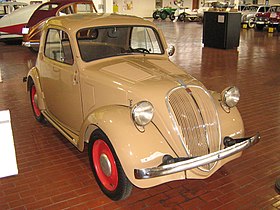Fiat 500 "Topolino"
You can help expand this article with text translated from the corresponding article in Italian. (March 2023) Click [show] for important translation instructions.
|
| Fiat 500 | |
|---|---|
 | |
| Overview | |
| Manufacturer | Fiat |
| Also called | Topolino |
| Production | 1936–1955 520,000 made |
| Assembly | |
| Designer | Oreste Lardone, Dante Giacosa |
| Body and chassis | |
| Class | City car (A) |
| Body style |
|
| Layout | Front-engine, rear-wheel-drive |
| Related | |
| Powertrain | |
| Engine | 569 cc I4 |
| Transmission | 4-speed synchromesh manual |
| Dimensions | |
| Wheelbase | 2,000 mm (78.7 in)[2] |
| Length | 3,215–3,245 mm (126.6–127.8 in) (saloon)[2] |
| Width | 1,275–1,288 mm (50.2–50.7 in)[2] |
| Height | 1,377 mm (54.2 in)[2] |
| Kerb weight | 550–750 kg (1,213–1,653 lb)[3] |
| Chronology | |
| Successor | |
The Fiat 500, commonly known as "Topolino"[4] (pronounced [topoˈliːno]), is an Italian city car produced and manufactured by Fiat from 1936 to 1955.
The name Topolino is Italian for 'little mouse', and is also the Italian name for Mickey Mouse.
History
[edit]

The Topolino was one of the smallest cars in the world at the time of its production. Launched in 1936, three models were produced until 1955, all with only minor mechanical and cosmetic changes. It was equipped with a 569 cc four-cylinder, side-valve, water-cooled engine mounted in front of the front axle[4] (later an overhead valve motor), and so was a full-scale car rather than a cyclecar. The radiator was located behind the engine which made possible a lowered aerodynamic nose profile at a time when competitors had a flat, nearly vertical grille.[4] The shape of the car's front allowed exceptional forward visibility.[5]
Rear suspension initially used quarter-elliptic rear springs, but buyers frequently squeezed four or five people into the nominally two-seater car, and in later models the chassis was extended at the rear to allow for more robust semi-elliptic springs.[5]
With a power of about 10 kW (13 bhp),[6] its top speed was about 85 km/h (53 mph), and it could achieve a fuel consumption of about 6 l/100 km (39 mpg‑US). The target price given when the car was planned was 5,000 lire.[5] The price at launch was 9,750 lire,[5] though the decade was one of falling prices in several parts of Europe and later in the 1930's the Topolino was sold for about 8,900 lire. Despite being more expensive than first envisioned, the car was competitively priced.[5] Nearly 520,000 were sold.
Three models were produced. The Model A and B shared the same body, but the engine of the model B had 12 kW (16 hp) of power, compared to the 9.7 kW (13 hp) of the Model A, produced from 1937 to 1948, while the model B was produced in 1948 and 1949. The model A was offered as a 2-door saloon, 2-door convertible saloon with a folding roof and a 2-door van,[1] while the Model B also introduced a 3-door estate under the name 500 B Giardiniera ("estate car").
The Giardiniera was initially only available as a so-called woodie, with an outside ash frame being used instead of steel, and was available in seven metallic colors. When it was later renamed the Belvedere, the wood was replaced with metal. This model and the regular two-seater Convertible-Limousine were also produced in France by Simca as the Simca 5, and in Germany by the German Fiat subsidiary NSU-Fiat.[7]
The Model C was introduced in 1949 with a restyled body and the same engine as the Model B, and was offered in 2-door saloon, 2-door convertible saloon, 3-door estate and 2-door van[8] body styles. In 1952, the Giardiniera was renamed the Belvedere ("A turret or other raised structure offering a pleasant view of the surrounding area", referring to its sunroof). The Model C was produced until 1955.[9]
In 1955 the larger rear-wheel-drive Fiat 600 was launched by Fiat and that would become the design basis for the new Fiat 500, the Nuova 500. These two models ended up replacing the original 500.
In popular culture
[edit]- La Topolino Amarante is a 1975 song by the Italian artist Paolo Conte. The song's lyrics are about the summer of 1946 (″È l'estate del '46″) so probably the mentioned car is the first model Fiat 500 A in amaranth color.[10]
Gallery
[edit]-
Fiat 500 A saloon 1939
-
Fiat 500 A convertible saloon 1939
-
Fiat 500 B van
-
Fiat 500 B Panoramica by Zagato
-
Fiat 500 C saloon 1949
-
Fiat 500 C convertible saloon 1954
-
Fiat 500 C Belvedere
-
Fiat 500 C van
References
[edit]Notes
[edit]- ^ a b Fiat 500 A, www.zuckerfabrik24.de Retrieved 6 June 2015
- ^ a b c d Fiat—Tutti i modelli del Novecento, p. 224, 246, 254.
- ^ 1937 Fiat 500 A Topolino full range specs
- ^ a b c Odin, L. C. (2015). World in Motion 1939 - The whole of the year's automobile production. Belvedere Publishing. ASIN B00ZLN91ZG.
- ^ a b c d e Frère, Paul (8 November 1969). "Dante Giacosa: A two part tribute to a great engineer". Motor. No. 3596. pp. 27–29.
- ^ "Fiat 500 'Nuova'". Motorbase. Retrieved 2010-09-17.
- ^ "Topolino-Club Deutschland e.V." www.topolino-club-deutschland.de. Archived from the original on 2019-12-21. Retrieved 2019-07-13.
- ^ Fiat 500 C Furgoncino, www.zuckerfabrik24.de Retrieved 6 June 2015
- ^ "Automobile-Catalog the complete Catalog of Cars, car specs database". www.automobile-catalog.com.
- ^ "La Topolino Amarante by Paolo Conte". Apple Music. Retrieved 2 December 2024.
Bibliography
[edit]- Fiat—Tutti i modelli del Novecento. Vol. I. Editoriale Domus. 2010.









